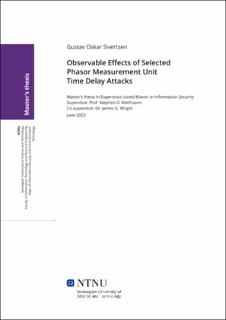| dc.contributor.advisor | Wolthusen, Stephen D. | |
| dc.contributor.advisor | Wright, James G. | |
| dc.contributor.author | Sivertsen, Gustav Oskar | |
| dc.date.accessioned | 2023-09-27T17:20:34Z | |
| dc.date.available | 2023-09-27T17:20:34Z | |
| dc.date.issued | 2023 | |
| dc.identifier | no.ntnu:inspera:139587736:17771937 | |
| dc.identifier.uri | https://hdl.handle.net/11250/3092516 | |
| dc.description.abstract | Det tradisjonelle elektriske kraftnettet, som leverer elektrisk kraft til konsumenter,
er i ferd med å bli transformert fra et system som er lukket og sentralstyrt et
nettverksstyrt automatisert system for å levere elektrisk kraft til forbrukere. Som
en del av denne transformasjonen transformeres kontroll- og overvåkingsundersystemene til det klassiske strømnettet fra å være et lokasjonsbasert lukket system,
til et Internett-tilkoblet Smart Grid. I tillegg distribueres nettverkstilkoblede enheter som måler og justerer strømforbruket til strømforbrukernes plassering.
Overgangen som beskrives åpner muligheten for at kraftdistribusjonsinfrastrukturen kan bli et tilbud for ondsinnede cyberangrep, med den potensielle hensikten
å forårsake strømbrudd, samt alvorlig skade på kritisk kraftnettinfrastruktur. Temaet for oppgaven min er å undersøke potensielle effekter av å sette faseormåleenheter for tidsforsinkelsesangrep, ved å utnytte kjente sårbarheter i IEEE 1588 Precision Time Protocol, observere eventuelle konsekvenser slik eksponering kan ha
på Synchrophasor-målinger, samt angrepsdeteksjonsevne.
Masteroppgaven omhandler sikkerhetstrusler rettet mot smart nettverk for distribusjon av elektrisk energi. Som en del av moderniseringen av strømnettet for å
møte framtidige behov, har infrastrukturen blitt tilknyttet Internett. Dette medfører sikkerhetsmessige utfordringer, ved at ondsinnede aktører kan utføre internettbaserte angrep på infrastrukturen. I tillegg har den nye infrastrukturen
et økt behov for kontinuerlig overvåking, slik at kravet til presisjon relatert til
åvå hendelser med korrekt tidsstempel er en nøkkel for å få en korrekt oversikt
over systemets tilstand. Dersom aktører kan forstyrre mekanismene som beregner
tidsstemplene til kritiske distribusjonskomponeneter, får operatørene som overvåker og styrer systemer feil beslutningsgrunnlag, noe som kan føre til feilaktig respons, basert på feilaktig grunnlag. Tidsstemplene blir beregnet basert på tidsdata,
ofte hentet fra klokker synkronisert via GPS, men også via klokkesynkronisering
over den nettverksbaserte PTP-protokollen. Masteroppgavens tema er i hvilken
grad smarte kraftdistribusjonssystemer er sårbare for at målrettet modifisering
av klokkesignalet medfører at feil i beregninger av tid skaper driftsforstyrrelser
basert på en feilaktig situasjonsforståelse.
Som en del av oppgaven kjøres simularinger i MATLAB og Simulink som viser
resultater som er forutsigbare nok til å kunne optimaliseres i forbindelse med
videre arbeid. | |
| dc.description.abstract | The traditional electric power grid, which delivers electric power to consumers, is
in the process of being transformed from a system that is closed and centrally controlled to a network-controlled automated system for delivering electric power to
consumers. As part of this transformation, the control and monitoring subsystems
of the classic power grid are transformed from being a location-based closed system, to an Internet-connected Smart Grid. In addition, network-connected devices
are distributed that measure and adjust power consumption to the location of
power consumers.
The transition described opens up the possibility that the power distribution infrastructure could become an offering for malicious cyber-attacks, with the potential
intent of causing power outages, as well as serious damage to critical power grid
infrastructure. The topic of my thesis is to investigate the potential effects of setting phasor measurement devices for time delay attacks, by exploiting known vulnerabilities in the IEEE 1588 Precision Time Protocol, observing any consequences
such exposure may have on Synchrophasor measurements, as well as attack detection capabilities.
The master’s thesis deals with security threats aimed at smart networks for the
distribution of electrical energy. As part of the modernization of the power grid
to meet future needs, the infrastructure has been connected to the Internet. This
entails security challenges, in that malicious actors can carry out internet-based
attacks on the infrastructure. In addition, the new infrastructure has an increased
need for continuous monitoring, so that the requirement for precision related to
monitoring events with a correct time stamp is a key to getting a correct overview of the system’s condition. If actors can interfere with the mechanisms that
calculate the time stamps of critical distribution components, the operators who
monitor and control systems get the wrong decision basis, which can lead to an
incorrect response, based on an incorrect basis. The time stamps are calculated
based on time data, often obtained from clocks synchronized via GPS, but also
via clock synchronization over the network-based PTP protocol. The theme of the
master’s thesis is the extent to which smart power distribution systems are vulnerable to the fact that targeted modification of the clock signal means that errors
in time calculations create operational disruptions based on an incorrect understanding of the situation.
As part of the task, simulations are run in MATLAB and Simulink which show results that are predictable enough to be optimized in connection with further
work. | |
| dc.language | eng | |
| dc.publisher | NTNU | |
| dc.title | Observable Effects of Selected
Phasor Measurement Unit
Time Delay Attacks | |
| dc.type | Master thesis | |
